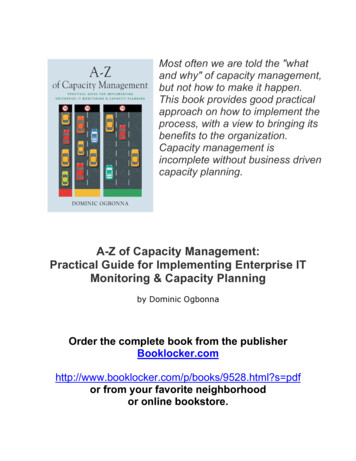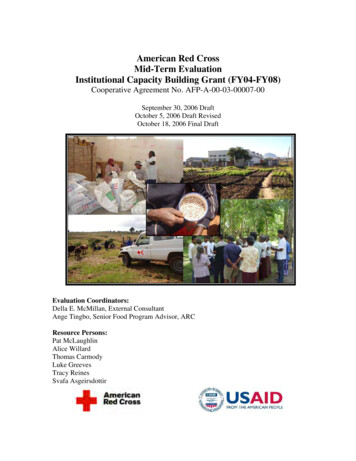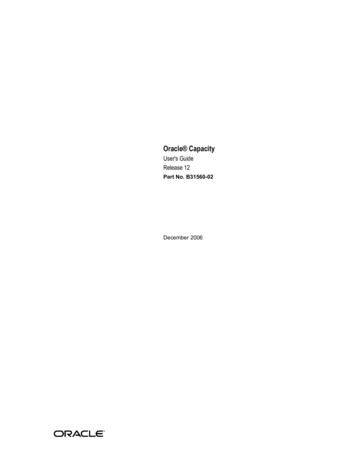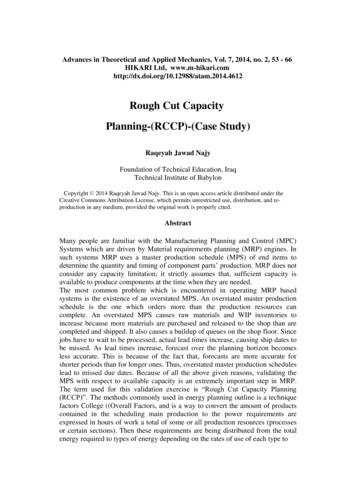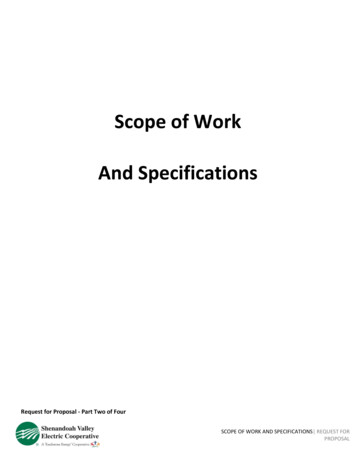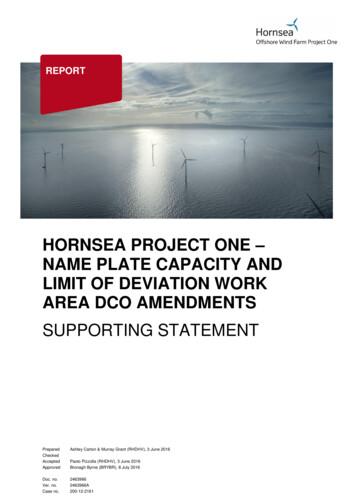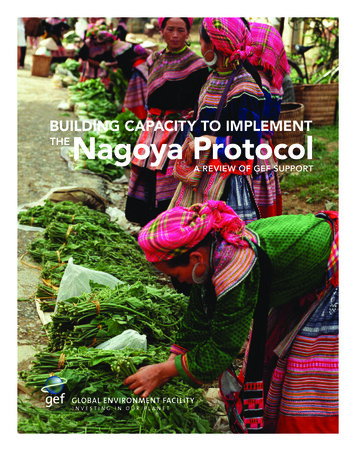
Transcription
BUILDING CAPACITY TO IMPLEMENTTHENagoya ProtocolA REVIEW OF GEF SUPPORT
Preface
Dr. Naoko IshiiCEO and ChairpersonGlobal Environment FacilityThe entry into force of the Nagoya Protocol during the 12 th Conference ofthe Parties to the CBD is a historical milestone that opens the doors for aglobal commitment on accessing and sharing benefits arising out of theutilization of genetic resources. The loss of biological resources and theirgenetic makeup, along with the knowledge of Indigenous Peoples and LocalCommunities (ILCs) on how to use many of these resources, are a significantconcern. The knowledge on the use of biological resources by ILCs has beenbuilt up over generations, making it essential that we protect them. Failing todo so, will put these communities and the biological resources at risk. Thesebiological resources provide a wide range of products and services for humanbenefit including products such as medicines, cosmetics, and ingredients ofinterest to the food and beverage industries. The genetic variability of plants,animals and microbes may hold the key to many challenges ahead of us, andwe need to protect them for our own good as well as for the generations tocome. It is critical to unlock the potential benefits to be gained by accessinggenetic resources, making use of them, and sharing the benefits derived fromtheir utilization.The GEF has supported ABS for more than a decade. As the financialmechanism of the Convention on Biological Diversity (CBD) the GEF hasassisted parties in building the capacities to comply with the third objective ofthe Convention, “the fair and equitable sharing of the benefits arising out ofthe utilization of genetic resources, including by appropriate access to geneticresources and by appropriate transfer of relevant technologies, taking intoaccount all rights over those resources and to technologies, and by appropriatefunding”. GEF’s support began in 2002 following a request by the Conferenceof the Parties to the CBD in its 6th meeting in The Hague. With the adoptionand entry into force of The “Nagoya Protocol on Access to Genetic Resourcesand the Fair and Equitable Sharing of Benefits Arising from their Utilization tothe Convention on Biological Diversity”, the commitment to support parties tocomply with the legally binding protocol is stronger than ever. Indeed, in theBiodiversity strategy for GEF-6 (2014-2018) there is a specific program to assistcountries to implement the Nagoya Protocol.In this publication, you will find a summary of the work on ABS supported by theGEF and some of the challenges and opportunities ahead of us. I invite partiesto the CBD to continue building capacities to comply with the Protocol andmake the most from the vast terrestrial and marine environments around theworld. The GEF Secretariat is ready to engage with countries and agencies tomake the most of this opportunity.BUILDING CAPACITY TO IMPLEMENT THE NAGOYA PROTOCOL: A REVIEW OF GEF SUPPORT1
SUMMARYThe GEF has invested more than 60 millionand leveraged 120 million in co-financingin over 100 countries in support of the thirdobjective of the Convention on Biodiversity(CBD): “the fair and equitable sharing of thebenefits arising out of the utilization of geneticresources, including by appropriate accessto genetic resources and by appropriatetransfer of relevant technologies, taking intoaccount all rights over those resources and totechnologies, and by appropriate funding”.The GEF started supporting capacity buildingprojects on Access and Benefit Sharing (ABSfor short) in 2003, following the request bythe COP to provide financial resources toassist Parties with the implementation of theBonn Guidelines, the voluntary provisionsthat allowed countries to implement theprovisions of the Convention on ABS. The GEFcreated a strategic objective and strategicprogram in the GEF biodiversity strategy forGEF-4 (2007-2010) titled “Building Capacityon Access and Benefit Sharing (ABS)”. Underthis strategy, the GEF supported a numberof national and regional projects to establishmeasures that promote access and benefitsharing agreements that recognize the coreABS principles of Prior Informed Consent(PIC), Mutually Agreed Terms (MAT) and the2THE GLOBAL ENVIRONMENT FACILITYfair and equitable sharing of benefits. Withthe adoption of the Nagoya Protocol in 2010,the GEF provided financial resources for theratification and implementation of the protocolthrough its GEF-5 Biodiversity Strategy (20102014) and the Nagoya Protocol ImplementationFund (NPIF) established in 2011. The NPIFsupported a number of projects with pilotsin support of existing partnerships and jointventures of governments, the private sector,and national and international academicand research institutions. These groups aresearching for genetic resources of interest tovarious sectors including pharmaceuticals,crop-protection, manufacturing/textile ,cosmetics and food-and-beverages. Terrestrialand marine organisms are being used asthe source of genetic material and obtainedin National or Regional Parks or throughengagement with private owners, indigenouspeoples and local communities, all withappropriate consent from the legitimateauthorities. The GEF will continue providingfinancial and technical assistance for theratification and implementation of the NagoyaProtocol and for pilot projects leading tolegally binding agreements between users andproviders of genetic resources during its 6thfunding cycle (2014-2018).
GEF Support to ABSFollowing the requests by the COP to provide financialresources to assist Parties with the implementation of theBonn Guidelines on ABS, the GEF-3 Biodiversity Strategy(2002-2006) prioritized support to ABS activities.Under this strategy, the GEF supported a number ofsmall projects that included components dealing withbenefit sharing agreements. These Enabling Activitiesassisted 22 countries to assess their capacity with regardto ABS1. Many of the projects with ABS componentsfunded during this period included in situ and on farmconservation of agricultural biodiversity (horticulturalcrops and wild fruit species) and crop wild relatives.Many of the projects included information managementand decision-support tools to conserve and sustainablyuse genetic diversity promoting sustainable livelihoods,food security and ecosystem services (pest controland diseases).Before the international legally binding Nagoya Protocolwas adopted, the GEF continued it support for ABS inthe GEF biodiversity strategy for GEF-4 (2006-2010) .GEF supported capacity building of governments formeeting their obligations under Article 15 of the CBD, aswell as building capacity within key stakeholder groups,including the scientific community, indigenous peoplesand local communities. The strategy also supported theestablishment of measures that promote concrete accessand benefit-sharing agreements that recognize the coreABS principles of Prior Informed Consent (PIC) andMutually Agreed Terms (MAT) including the fair andequitable sharing of benefits. Projects in this strategicprogram were consistent with the non-legally bindingBonn Guidelines. During this period the GEF approvedfive projects on ABS for a total of 8.4 million which leveraged 10.4 million in co-financing: three regionalprojects [Africa (Photo 1), Latin American and theCaribbean, and Asia] assisting a total of 40 countries,and two national projects, one in Ethiopia (Photo 2) andPhoto 1. Rice fields in Madagascar, one of the countries participating in the regional project GEF-UNEP ID 2820 “Supporting the Development and Implementation of ABSPolicies in Africa”. Photo by Jaime Cavelier1Armenia, Benin, Burkina Faso, Burundi, Central African Republic, Congo, Congo DR, Dominica, El Salvador, Estonia, Ethiopia, Gabon, Gambia,Guinea Bissau, Jamaica, Federal Republic of Micronesia, Panama, Samoa, Sudan, Uruguay and ZimbabweBUILDING CAPACITY TO IMPLEMENT THE NAGOYA PROTOCOL: A REVIEW OF GEF SUPPORT3
Photo 2. The market at Bahir Dar, Ethiopia. During GEF-4, Ethiopia received a grant “Capacity Building for ABS and Conservation and Sustainable Use of Medicinal Plants”.UNEP is the GEF Agency. Photo by Jaime Cavelier.one in India (Photo 3). These projects focused on developing national ABS policies and regulations, strengthening the capacity of stakeholders and institutions onABS, and building public awareness on ABS issues. TheGEF has also supported ABS through Enabling Activitiesin Morocco (Photo 4), Pakistan and Mozambique, with atotal investment of 0.7 million. Hence, total investmentin ABS was 9.1 million of GEF resources.In GEF-5 (2010-2014) , GEF continued its focus onbuilding capacity for ABS though the establishment ofmeasures that promoted access and benefit-sharingagreements that recognize the core ABS principles ofPrior Informed Consent (PIC) and Mutually Agreed Terms(MAT) including the fair and equitable sharing ofbenefits. During this period, the GEF Trust Fund invested 37.1 million and leveraged 82 million in co-financing.These funds were invested in 10 national projects(Algeria, Bahamas, Brazil, China, Ecuador, Guatemala,Malaysia, Mexico, Morocco and Vietnam – Photo 5) oneregional project (10 Caribbean countries) and two globalprojects (one for up to 30 countries for ratification andone for up to 25 for ratification and implementation). Thenational projects were granted to advance the ratification and implementation of the basic measures of theNagoya Protocol. In a few cases (i.e. China, Ecuador,Malaysia and Vietnam), countries decided to use some ofthe funds allocated by the GEF by means of the System4THE GLOBAL ENVIRONMENT FACILITYPhoto 3. Wheat harvest in central India. During GEF-4, India received the grant“Strengthening the Implementation of the Biological Diversity Act and Rules withFocus on its ABS Provisions”. UNEP is the GEF Agency. Photo by Scott Wallace(World Bank Photo library).of Transparent Allocation of Resources (STAR) to carryout pilot projects on ABS agreements between users andproviders of genetic resources.During GEF-6 (2014-2018), the GEF will continue tosupport the Nagoya Protocol. Projects funded under theGEF Trust Fund and allocated via the STAR, will supportnational and regional implementation of the NagoyaProtocol, build capacity among stakeholders, andenhance the value of genetic resources. Specifically,the GEF will support stocktaking and assessments,
Photo 4. Women extracting oil from Argan seeds in Morocco. During GEF-4, the country benefited from an enabling activity in support of ABS. Photo by Jaime Cavelier.Photo 5. Beginning of the rice harvest, Mai Chau, Hoa Binh province, northern Vietnam. Photo by Tran Thi Hoa (World Bank Photo Gallery).the development and implementation of a strategy andaction plan for the implementation of ABS measures (i.e.legal framework, administrative systems and institutionalarrangements) and building capacity among stakeholders to participate in policy, legal and decisionmaking processes, and develop domestic protocols,model contractual clauses, and minimum requirementsto secure the fair and equitable sharing of benefits in linewith the Nagoya Protocol. Countries may consider institutional capacity-building to carry out research anddevelopment associated with the valorisation of geneticresources (bio-prospecting). The GEF will also supportthe participation in the ABS Clearing-House mechanismas soon as it is operational.BUILDING CAPACITY TO IMPLEMENT THE NAGOYA PROTOCOL: A REVIEW OF GEF SUPPORT5
THE NAGOYAPROTOCOLIMPLEMENTATIONFUND (NPIF)As the President of COP-10, Japan proposed to establisha new multi-donor trust fund to promote the early entryinto force and effective implementation of the NagoyaProtocol on Access to Genetic Resources and the Fair andEquitable Sharing of Benefits Arising from their Utilization.The new fund was to be managed by the GEF with theWorld Bank serving as the Trustee.The creation of the Nagoya Protocol ImplementationFund (NPIF) was approved by the GEF Council onFebruary 18, 2011. Further to the creation of the fund, theGEF Council approved the arrangements proposed forthe operation of this new multi-donor trust fund during itsspring meeting of 2011. The terms of the NPIF are in thedocument GEF/C.40/11/Rev.1, Outstanding Issues Relatedto the Nagoya Protocol Implementation Fund. The NPIFreceived contributions for a total of 16 million, generouslymade available by the Governments of Japan, France,Norway, Switzerland and the United Kingdom.The NPIF started its operation in the summer of2011, with the first grant awarded in December2011. By the end of GEF-5 (June 30, 2014), the NPIFinvested 13 million and leveraged 31.8 million in cofinancing. These funds are allowing the developmentof 10 national projects (Argentina, Bhutan – Photo 6,Photo 6. Farmers, agricultural fields and native forests in the mountains of Bhutan where natural compounds will be used for the development of cosmeticsand pharmaceutical products Photo by Curt Carnemark (World Bank Photo Collection).6THE GLOBAL ENVIRONMENT FACILITY
Cameroon, Cook Islands, Colombia, Costa Rica,Fiji, Gabon, Kenya, and Panama), 2 regionalprojects (Africa and Pacific) and 1 Globalproject. The country projects have a twopronged approach: advancing the ratificationand implementation of the basic measures ofthe NP, and piloting ABS agreement betweenusers and providers of genetic resources.These pilots are meant to inform nationalimplementation of the Protocol. They areaccessing resources in National Parks orthrough engagement with indigenous peoplesand local communities. The regional projectin Africa is allowing the member countries ofCOMIFAC (Burundi, Central African Republic,Congo, Cameroon, Gabon, Equatorial Guinea,Rwanda, Sao Tome and Principe, Chad andthe Democratic Republic of Congo) to worktowards the ratification and implementationof the Nagoya Protocol. The regional projectin the Pacific has similar objectives for the 12member countries of SPREP (Cook Islands, Fiji,Micronesia, Kiribati, Marshall Islands, Nauru,Niue, Papua New Guinea, Palau, SolomonIslands, Tonga, Tuvalu, Vanuatu and Samoa). Theglobal project is supporting the Ratification ofthe protocol in up to 30 countries. This projecttargeted countries that did not require thedevelopment of the entire legal and regulatoryframework for ratification. By the end of GEF5, 20 countries had benefited from this grant(Angola, Armenia, Burkina Faso, Belarus, Bosnia& Herzegovina, Cote d’Ivoire, Djibouti, Egypt,Guinea Bissau, Kazakhstan, Kyrgyzstan Lesotho,Malawi, Mauritania, Niger, Nigeria, Sierra Leone,Swaziland, Togo, Uganda, Zimbabwe).CHALLENGES ANDOPPORTUNITIESTO IMPLEMENTTHE PROTOCOLThe development and implementation of ABS projectsover the last decade has provided the GEF with significant insights into the challenges and opportunitiesfacing countries willing to engage in providing accessand sharing the benefits derived from the use of thegenetic resources under the provisions of the NagoyaProtocol. These include the requirements and procedures for ratification, how to establish the appropriatelegal and administrative procedures for users andproviders of genetic resources to engage, how toaddress issues related to traditional knowledge and howto make the best out of the relationships with ILCs, theimplications of sourcing for biological material inside andoutside of protected areas, how to add value to geneticresources through research and development, how tostructure effective partnerships with domestic and international partners, and determining the appropriatetargets in public awareness campaigns to ensure buy inon the part of key stakeholders. Here we elaborate onthese challenges and opportunities using GEF fundedprojects as examples.RATIFICATION AND IMPLEMENTATIONOF THE NAGOYA PROTOCOLThe Nagoya Protocol has been signed by 92 countriesand has already been ratified by more than 50 countries,allowing for the protocol to enter into force at the firstCOP-MOP to take place in Pyeongchang, Republic ofKorea, in October 2014. Of the 92 signatories, the GEFsupported 15 countries with country-based or regionalprojects during GEF-4 (2006-2010). The GEF is alsoinvesting in 22 of the 50 countries that ratified theprotocol using financial resources from GEF-5BUILDING CAPACITY TO IMPLEMENT THE NAGOYA PROTOCOL: A REVIEW OF GEF SUPPORT7
(2010-2014). Funds are being used to implement thebasic measures of the protocol. There are also countriesthat have not signed and/or ratified the protocol thathave also received funding from the GEF. All in all, theGEF has supported over 100 countries in fulfilling theirobligations under the third objective of the CBD, withmore than 60 million invested and 120 million leveraged in co-financing. During GEF-6 (2014-2018), therewill be opportunities for countries to use the fundsallocated to countries through the System of TransparentAllocation for Resources (STAR) to further advance thenational ABS agenda.GEF financial resources have been invested by means ofnational, regional and global projects. Ten countries(Algeria, Bahamas, Brazil, China, Ecuador, Guatemala,Malaysia, Mexico, Morocco and Vietnam) used some oftheir GEF-5 STAR allocations to put in place the legal-,regulatory-, institutional- and administrative-systemsneeded to comply with the basic provisions of theProtocol. Some of these countries (i.e. China, Ecuador,Malaysia and Vietnam), included a component to pilotsome ABS agreements between users and providers ofgenetic resources. Regional projects in the Caribbean,Africa and the Pacific are also being used to createcapacity needed in order to comply with the Protocol.These regional projects will deliver technical and financialassistance to the participating countries using a twopronged approach: first, the projects will group countriesaccording to needs and deliver assistance by means ofspecialized consultancy services (i.e. scooping analysisand step wise approach to achieve targets, like ratification) or workshops on specific topics (i.e. capacitybuilding); second, they will deliver technical and financialassistance on a country by country basis (i.e. public awareness campaigns and building institutional capacities in theGovernment agencies). These regional projects arebuilding on a common geography or political support likein the case of the regional project in central Africa“Ratification and Implementation of the Nagoya Protocolfor the Member countries of the Central African ForestsCommission COMIFAC”. This project counts on significantpolitical support for ABS in the region. Indeed, COMIFACmembers signed a presidential agreements in 2011 toadvance the ABS agenda in the region (“Strategie despays de l’espace COMIFAC relative a l’acces auxressources biologiques/genetiques et au partage juste etequitable des avantages decoulant de leur utilisation’).8THE GLOBAL ENVIRONMENT FACILITYLEGAL CERTAINTY ANDADMINISTRATIVE PROCESSESThe GEF is currently supporting projects in over 50countries to develop or strengthen the policy-, legal- andregulatory frameworks to comply with key provisions ofthe Nagoya Protocol. In GEF-5, the GEF provided grantsupport to conduct a comprehensive review and developthe policy and regulatory frameworks in countries in LatinAmerica and the Caribbean (Bahamas, Brazil, Costa Rica,Ecuador, Guatemala, Mexico and Panama), Africa(Algeria and Morocco) and Asia (Malaysia, Bhutan, Chinaand Vietnam). A common denominator among thesecountries is that they have elements of the law and evendraft legislation governing the use of genetic resources.Furthermore, these countries have some of the institutions necessary to administer the process and/or monitorthe granting of permits for Prior Informed Consent (PIC),Mutually Agreed Terms (MAT) and benefit sharing,needed for user and providers of genetic resources alike.In these cases, GEF financial resources will facilitatedeveloping a comprehensive system that set the rules foraccessing and sharing the resources derived from theuse of genetic resources. Some resources are being usedto complete building the institutional capacity to administer these processes, including the definition of theNational Focal Points and the role and structure of theNational Competent Authorities. In cases where thelegislative agenda is insipient or non-existing, or theinstitutional capacity is weak, the GEF funds will serve toput in place the basic elements to address the requirements of the Nagoya Protocol. Having a minimum set oflegal and administrative measures in place and the institutional capacity to oversee the process, are conditionssine qua non for users and providers of genetic resourcesto engage legally binding agreements on the access, useand sharing of benefits derived from their utilization.TRADITIONAL KNOWLEDGEMost GEF funded projects on ABS include componentsthat relate directly or indirectly with indigenous peoplesand local communities (ILCs). Activities in support ofengaging ILCs on the ABS agenda are a commondenominator in the GEF portfolio, because ILCs live inthe areas where the genetic resources are located.There are a number of projects where ILCs are not onlyincluded with other stakeholders but play a central role
in cases where legally binding agreements between theusers of genetic resources are being negotiated. Forinstance, the project “A Bottom up Approach to ABS:Community Level Capacity Development for SuccessfulEngagement in ABS Value Chains in Cameroon(Echinops giganteus)”, will result in the increasedcapacity of ILCs to engage with users of geneticresources by strengthening the value chains of productsderived from the plant Echinops giganteus, a species ofinterest to the fragrance and flavor industries. Theproject “Production of Natural Dyes in the ChocoRegion of Colombia for the Food, Cosmetics andPersonal Care Industries under the Provisions of theNagoya Protocol” will allow a partnership in the Pacificlowlands of Colombia to scale up the production ofnatural dyes derived from the plant Genipa americana.The dyes are of interest to the food, cosmetics andpersonal care industries. The project will improve thecapacity of the local communities to collect the fruitsaccording to sustainability and biodiversity conservation criteria and develop ABS agreements with theusers of the dyes (Photo 7). The project “Strengtheningthe Implementation of the Nagoya Protocol on Accessto Genetic Resources and Benefit Sharing in the CookIslands” will result in the strengthening of the nationaland customary regulatory framework in compliance withthe NP, the capacities of the local communities onsustainable cultivation/collection of plant material, andconservation of the habitats of “Au” H. tiliaceus. Theproject will also support the revision of existing ABSagreement to ensure compliance with the NP, andimproved facilities and extraction protocols for theactive compound derived from this plant. In Bhutan,the GEF is supporting the project “Implementing theNagoya Protocol on Access to Genetic Resources andBenefit Sharing in Bhutan”. In this project, ABS agreements will be negotiated between the companies,National Biodiversity Centre (NBC) and the communities. These agreements will include the use and protection of traditional knowledge associated with biologicalresources used as the source of active compounds for thedevelopment of cosmetic and pharmaceutical products.NATIONAL AND REGIONAL PARKSA number of GEF funded projects are sourcing geneticresources from national or regional parks. In the project“Promoting the application of the Nagoya Protocol onPhoto 7. Testing the blue dye derived from the plant Genipa americana, a native species in thePacific Lowlands of Colombia. Photo Ecoflora.Access to Genetic Resources and Benefit Sharing inPanama”, GEF funds will assist in the discovery of activecompounds from marine organisms (mainly corals) andthe improvement of the infrastructure of Coiba NationalPark, where coral samples are being collected (Photo 8).In the project “Developing the Microbial BiotechnologyIndustry from Kenya’s Soda Lakes in line with the NagoyaProtocol” the GEF is supporting a series of activities tocarry out research and development on geneticresources from micro-organisms collected in the SodaLakes. The project is supporting the development oftourism infrastructure in these National Parks. In Fiji, theproject “Discovering nature-based products and buildingcapacities for the application of the Nagoya Protocol onAccess to Genetic Resources and Benefit Sharing”,bio-prospecting work will be linked strongly to biodiversity conservation through management planning withlocal communities.BUILDING CAPACITY TO IMPLEMENT THE NAGOYA PROTOCOL: A REVIEW OF GEF SUPPORT9
Photo 8. Coiba National Park, Panama. During GEF-5, Panama received the first grant from the “Nagoya Protocol Implementation Fund. The project is entitled “Promotingthe application of the Nagoya Protocol on Access to Genetic Resources and Benefit Sharing in Panama”. Photo by ICBG-Panama.PUBLIC AWARENESSActivities to build capacity and raise awareness aboutthe Nagoya Protocol are included in each and all ofthe GEF funded projects. These investments cover awide range of audiences, including Indigenous andLocal Communities (ILCs), government officials and theprivate sector. GEF funds are being used to develop,disseminate and put into practice “Communication,Education, Participation and Awareness” (CEPA) plans.These plans will allow clarifying the scope, rules andbenefits that should be expected when engaging inagreements on the use of genetic resources.RESEARCH AND DEVELOPMENTThe GEF is supporting a number of countries improvingtheir institutional and human capacities for research anddevelopment (R&D) of genetic resources. Increasing thevalue of genetic resources via R&D is central not only tothe Nagoya Protocol, but to scientific and technologicaldevelopment policy of parties to the Protocol, and somecountries are advancing on this front. For instance,in the project “Strengthening the Implementation ofthe Nagoya Protocol on Access to Genetic Resources10THE GLOBAL ENVIRONMENT FACILITYand Benefit Sharing in the Cook Islands”, the GEFis supporting a consortium to improve facilities andextraction protocols for compounds derived fromthe plant “Au” (Hibiscus tiliaceus). These compoundsare known to have bone and cartilage regenerationproperties (Photo 9). In the project “Promoting theApplication of the Nagoya Protocol through theDevelopment of Nature-based Products, Benefit-sharingand Biodiversity Conservation” in Costa Rica, GEF fundsare supporting the scientific research process needed tovalidate the potential of a sugar alkaloid (derived fromthe tree of the genus Lonchocarpus) and a compoundderived from a micro fungus, for the production ofcrop-protection products (Photo 10). In the project“Promoting the application of the Nagoya Protocol onAccess to Genetic Resources and Benefit Sharing inPanama”, the GEF is supporting a joint-venture with theGovernment of Panama, the private sector and nationaland international academic and research institutionsin search of active compounds derived from marineorganisms of interest to the pharmaceutical sector. In thisproject as well as in Kenya, “Developing the MicrobialBiotechnology Industry from Kenya’s Soda Lakes in linewith the Nagoya Protocol”, the GEF is supporting thetransfer of technology between users and providers of
genetic resources, including equipment, know-how andtraining. Another example of GEF support in R&D is theproject “Implementing the Nagoya Protocol on Accessto Genetic Resources and Benefit Sharing in Bhutan”.In this case, there is a pilot aiming at the identificationof lead compounds for the development of cosmeticand pharmaceutical products. The partners in thisproject include the Government of Bhutan, the BhutanConservation Trust Fund, and the private sector.MARINE BIO-PROSPECTINGThe portfolio of GEF projects in support of ratification ofthe Nagoya Protocol include a number of pilots wherethere is bio-prospecting on marine organisms. Theseprojects include “Promoting the application of theNagoya Protocol on Access to Genetic Resources andBenefit Sharing in Panama”, and “Discovering NatureBased Products and Building Capacities for theApplication of the Nagoya Protocol on Access to GeneticResources and Benefit Sharing – Fiji”(Photo 11) . Theproject in Panama will concentrate on the discovery ofnature-based products for the pharmaceutical andagrochemical industries and promote the conservationof genetic resources in the Protected Areas System ofPanama, with particular emphasis on Coiba National Park.The project in Fiji will allow a joint venture to strengthenbio-prospecting through state of the art technology, theidentification of highly active compounds of interest tothe pharmaceutical and agrochemical industries, andmake ABS Agreements and Benefit Sharing operationalby linking bio-prospecting with marine conservationactions lead by local communities. There is also a projectin Bahamas “Strengthening Access and Benefit Sharing(ABS) in the Bahamas” that will advance the nationalagenda on ABS and use a long standing businessrelation between the Government and the private sectoron nature-based products to build proper ABS agreements under the provisions of the Nagoya Protocol.Photo 9. Newly constructed extraction facility on Rarotonga for the CIMTECH Technology.Photo Lorinda Matheson.Photo 10. Banana plants being treated with a natural compound being developed at INBioagainst fungal and bacterial diseases (Photo INBIo, Costa Rica).JOINT-VENTURESThe Nagoya Protocol Implementation Fund (NPIF)funded a number of projects with pilots in support ofexisting partnerships and joint ventures searching foractive compounds of interest to various sectors includingpharmaceuticals, manufacturing/textile, and cosmeticsand food-and-beverages. In Argentina, the GEF issupportin
the COP to provide financial resources to assist Parties with the implementation of the Bonn Guidelines, the voluntary provisions that allowed countries to implement the provisions of the Convention on ABS. The GEF created a strategic objective and strategic program in the GEF biodiversity

